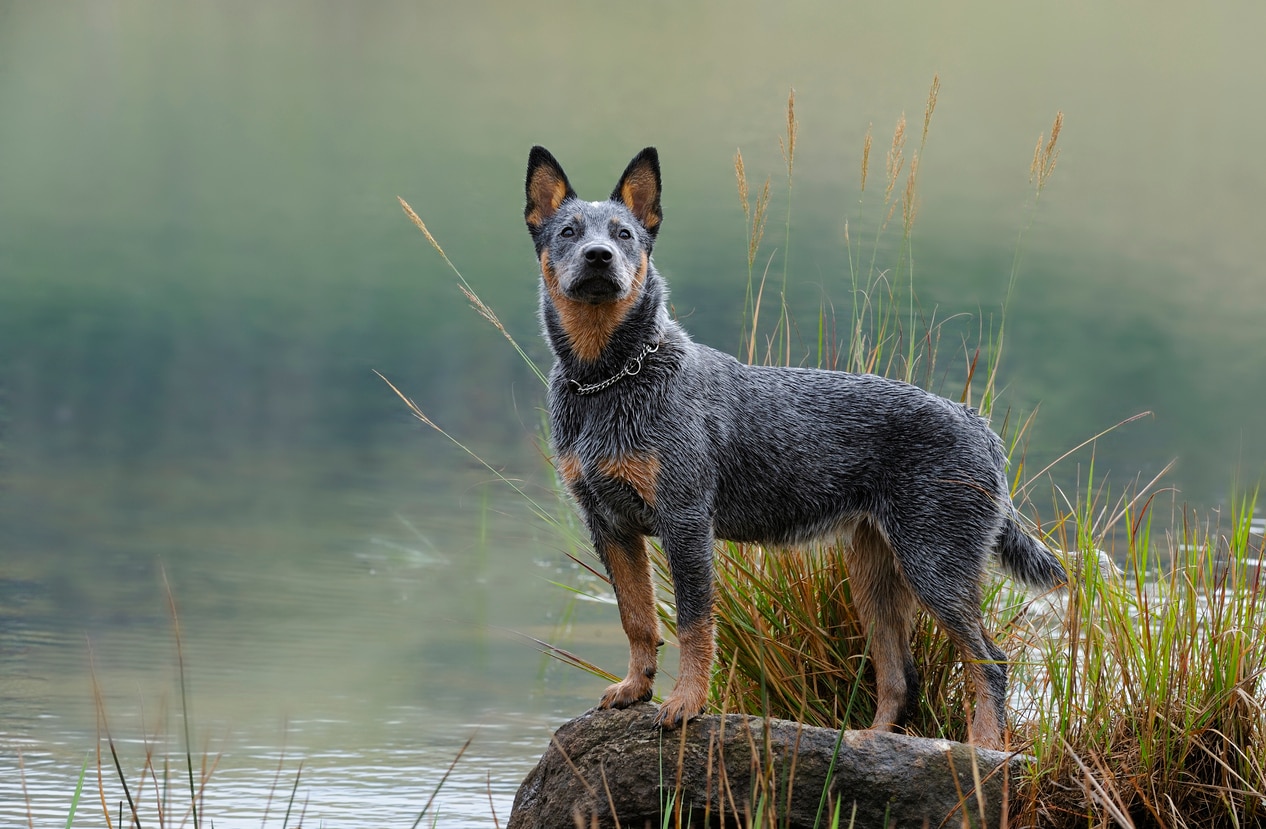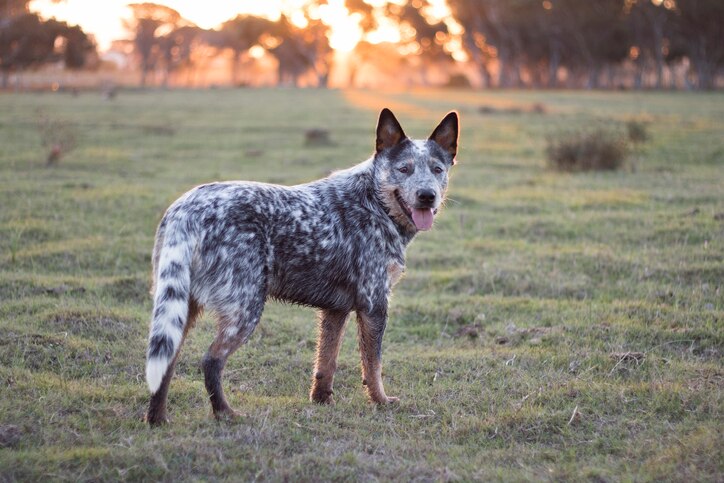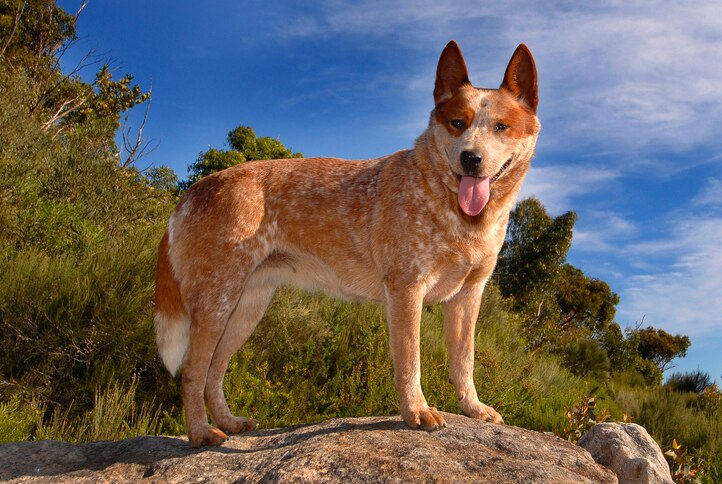Blue Heeler Puppies the Biggest Spider in the World World Record

Descended from the dingo and bred to herd animals, Australian Cattle Dogs are known for their extraordinary intelligence and go, go, go personality. Australian Cattle Dogs come in two colors—blue and red speckle—frequently referred to as a "Blue Heeler" or "Red Heeler." The term is in reference to how they nip at the heels of animals when herding.
Australian Cattle Dogs are medium-sized dogs weighing in at 35-50 pounds and 17-20 inches tall. Classified in the herding group of dogs, Australian Cattle Dogs should not exceed 50 pounds in weight or 20 inches in height.
According to the Guinness Book of World Records, the oldest living dog was an Australian cattle dog named Bluey who lived to be 29 years old.
Caring for an Australian Cattle Dog
Australian Cattle Dogs are known for their stocky, muscular build designed to maximize strength, endurance, and stamina.
They are double-coated with short, dense undercoats and water-resistant straight outercoats. They do well in hot or cold climates and can thrive outdoors with adequate shelter, but they also enjoy being indoors with their owners.
Australian Cattle Dogs require a high degree of exercise and do best with extended sessions of running, jogging, frisbee, fetch, or agility training. They are not well suited to apartment living or in a small living space/yard.
With fierce devotion to their owners, Australian Cattle Dogs often bond strongly to one person and will object to being separated from them.
Australian Cattle Dog Health Issues
Fortunately, Australian Cattle Dogs are a generally healthy, hardy breed with few health concerns.
The most common health conditions that potential owners need to be aware of for Australian Cattle Dogs are heart conditions, eye defects, deafness, or orthopedic issues including hip dysplasia.
Eye Issues
Australian Cattle Dogs can be predisposed to progressive retinal atrophy (PRA). PRA is an inherited form of degenerative ocular disease with no treatment or cure. It progresses to blindness but is non-painful for the pet.
In the early stages of the disease, affected dogs will experience night blindness. Eventually, they will lose all vision. It is important to know that most dogs do well with partial or complete loss of vision, as long as their surroundings are constant. If you have concerns about your pet's vision or they are running into things, it is recommended to check with your veterinarian.
Deafness
Deafness in Australian Cattle Dogs is an inherited condition. Hearing can be tested by your primary care veterinarian using loud noises or a tuning fork, but definitive testing can be performed at some specialty hospitals or veterinary teaching hospitals/universities.
This advanced testing is called "brainstem auditory evoked response" (BAER) testing and can be a useful tool to confirm deafness. Unfortunately, there is no treatment or cure for deafness. However, most deaf dogs can live full and happy lives with minimal accommodation, such as hand signals for commands in place of verbal commands.
Orthopedic Issues
Infrequently, Australian Cattle Dogs can develop hip dysplasia. Hip dysplasia is an instability or loose fit of the hip joint that occurs in growing dogs because the hip socket does not fully cover the ball portion of the thigh bone. This can result in hip arthritis and pain.
Clinical signs of hip dysplasia include:
- Pain
- Decreased range of motion in the hips
- Decreased activity
- Limping in the rear limbs
Typically, these symptoms can be managed with a joint supplement or a non-steroidal anti-inflammatory drug (NSAID) medication. However, if the dog is severely affected, there are a few surgical options you can discuss with your veterinarian.
Talk with your veterinarian about PennHIP screening if you are concerned that your Australian Cattle dog might be at risk of hip dysplasia. PennHIP is a specialized X-ray screening of the pelvis that can detect whether a dog is likely to develop hip dysplasia in their lifetime.
What to Feed an Australian Cattle Dog
With a wide variety of diet options, it can be daunting to choose the right food for your Australian Cattle Dog. An AAFCO (Association of American Feed Control Officials)-approved food is a good place to start to ensure your selected food meets standard nutritional requirements and regulations for pet foods. You should also be sure you are feeding a diet that is appropriate for their life stage (puppy, adult, or senior).
Other considerations for Australian Cattle Dogs are their athletic, active lifestyle, so high-quality, calorically dense diets may be ideal. However, be sure to consult with your veterinarian regarding your pet's specific needs when selecting a diet.
How to Feed an Australian Cattle Dog
As working dogs, Australian Cattle Dogs may benefit from a few feedings throughout the day—typically 2 feedings per day. They may also need an increase in amount of food or extra meals on days where they exert a lot of energy, such as working cattle or at an agility show.
How Much Should You Feed an Australian Cattle Dog
When determining how much to feed your dog, it is important to read the instructions on the bag or can. The caloric content of each food can vary significantly, and the food bag or can is the best place to make that determination.
Typically, you will need to consider your dog's age and weight to compare to the chart on the bag. Maintaining a healthy weight and monitoring your pet's caloric intake are keys to a healthy lifestyle. So be sure to discuss your Australian Cattle Dog's ideal weight with your veterinarian and adjust the amount you are feeding based on ideal weight, not current weight.
Also, don't forget that treats count as calories too. So while they are great for training, giving too many can lead to overweight heelers.
Nutritional Tips for Australian Cattle Dogs
Always discuss any potential supplements or diet aids with your veterinarian prior to starting them, to ensure they are right for your pet.
With their extremely active lifestyles, Australian Cattle Dogs may benefit from joint supplements containing glucosamine and chondroitin to maintain healthy cartilage.
Behavior and Training Tips for Australian Cattle Dogs
Personality and Temperament
Australian Cattle Dogs are tremendously intelligent, hard-working dogs characterized by an intense protective nature for their owners and property. They bond strongly to their owner and are curious but wary of strangers. They can become aggressive when threatened or cornered but are generally friendly and eager to please their owners.
Australian Cattle Dogs do not make good sedentary house pets and require a job as an outlet for their high-energy personality. They will try to herd small children, and some adults, so supervision is needed.
Australian Cattle Dogs can be considered "mouthy" in that they tend to nip or bite, but this behavior can be redirected with proper training and socialization.
Australian Cattle Dog Behavior
Australian Cattle Dogs are courageous and will fearlessly take on animals (cattle, sheep, and even other dogs) that are bigger than them. They are strong-willed and selective when making friends.
When not properly stimulated mentally or physically, Australian Cattle Dogs can act out with destructive behaviors, or they may develop conditions like separation anxiety.
Due to their high degree of loyalty and bonding, adult Australian Cattle Dogs can struggle with rehoming or changing owners—these dogs are lifelong commitments.
Australian Cattle Dog Training
Given their high degree of intelligence and ability to problem-solve for themselves, Australian Cattle Dogs are highly trainable and enjoy learning new tricks.
They will benefit from socialization to help curb some nipping tendencies, and obedience training is recommended to help ensure a well-mannered dog. Australian Cattle Dogs can be stubborn and require a firm but gentle hand—they will respond best to positive reinforcement techniques.
As herding dogs, they will enjoy high-impact activities such as agility, frisbee, and fetch. They are good candidates to compete in canine sports. Given their ancestry and drive, they are also excellent farm working dogs and can easily be trained to help with livestock and property patrolling.
Fun Activities for Australian Cattle Dog
-
Agility
-
Frisbee
-
Fetch
-
Obedience training
-
Farm work, working animals/herding
-
Running/jogging daily for at least 45 minutes
Australian Cattle Dog Grooming Guide
Considered short-haired dogs, Australian Cattle Dogs are double-coated with short, dense undercoats and rain-resistant straight outercoats. They come in two colors: blue and red speckled.


Australian cattle dog puppies are born with an all-white coat but by 4-6 weeks of age they will have a distinct color.
Skin Care
No special care is needed for their skin. Australian Cattle Dogs have very dense undercoats that protect the skin and waterproof outer coats. Like any dog, they can develop skin allergies, but this is uncommon.
Due to their active lifestyle and outdoor presence, year-round heartworm prevention and flea and tick prevention are highly recommended.
Coat Care
Australian Cattle Dogs shed a moderate to high amount and will benefit from daily brushing.
Twice per year, they will shed their dense undercoats and can benefit from blowout by a professional groomer or bather.
They require only occasional baths, unless they have been playing in the mud. As with all breeds, nail trims should be performed to keep the nails neat and short.
Eye Care
Australian Cattle Dogs are rough and tumble workers who can sustain a scratch to the eye or other injuries on the job. If your dog's eyes are red or they are rubbing at them, check with your veterinarian.
In addition, given their breed risk for progressive retinal atrophy (PRA), check with your veterinarian immediately if you have concerns about your pet's vision.
Ear Care
Regular ear cleanings should be performed, especially at bath time. If the pet parent notices debris or odor in the ear, contact your veterinarian.
Considerations for Pet Parents
Researching this breed is crucial to determining if you and your lifestyle are ideal for an Australian Cattle Dog. They are loving, loyal, protective companions for the active owner who is excited and committed to finding them jobs or working them on farms or through canine sports.
Australian Cattle Dogs who do not receive enough stimulation mentally and physically can become frustrated and act out in destructive ways. This can progress to severe separation anxiety that impacts the lives of both the dog and pet parent.
Australian Cattle Dog FAQs
Is an Australian Cattle Dog a good family dog?
Australian Cattle Dogs can be good family dogs, and can be raised with children. They are playful and will enjoy the high-energy companionship of children. However, given the breed's propensity to nip and herd, they should be supervised when around young children.
Are Australian Cattle Dogs smart?
Yes, extremely. Australian Cattle Dogs are one of the most intelligent dogs you will find.
What are the drawbacks of an Australian Cattle Dog?
Australian Cattle Dogs need a job. They will not be content as couch potatoes and are not well suited to apartment living. However, they will do well with owners who are interested in high-energy, active companions.
What is the difference between a Blue Heeler and an Australian Cattle Dog?
There is no difference—they are the same breed. All blue heelers are Australian Cattle Dogs, but not all Australian Cattle Dogs are blue heelers; some are red heelers.
What do Australian Cattle Dogs love to do?
Australian Cattle Dogs love working, whether it is on the farm to herd livestock or in canine sports such as agility, frisbee, or fetch.
Why are Australian Cattle Dogs so tough?
Bred to work on a farm, Australian Cattle Dogs are clever and will take on animals much larger than themselves with gusto and fearlessness. They can handle hot and cold climates, rain, shine, or snow.
Are Australian Cattle Dogs the same as Australian Shepherds?
These two breeds are often confused but are not related. Australian Shepherds are larger and have longer, fluffier haired compared to the more compact, short-haired Australian Cattle Dog.
Featured Image: iStock.com/WOLFAVNI
Source: https://www.petmd.com/dog/breeds/c_dg_australian_cattle_dog
0 Response to "Blue Heeler Puppies the Biggest Spider in the World World Record"
Post a Comment